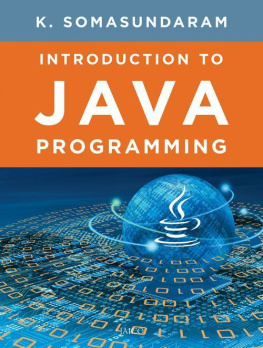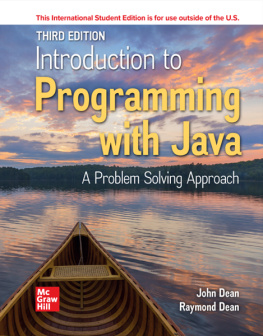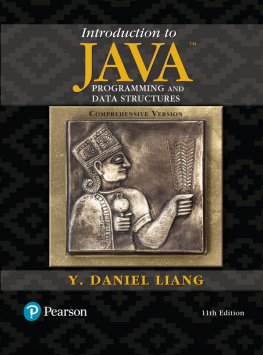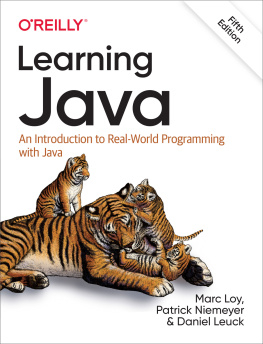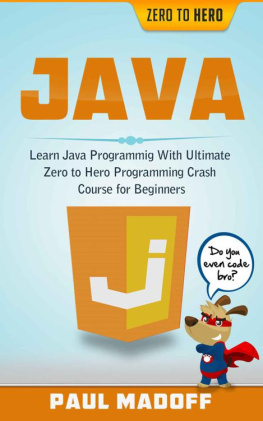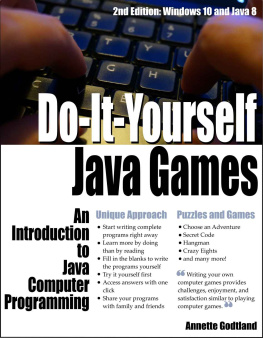K. Somasundaram [Somasundaram - Introduction to Java Programming
Here you can read online K. Somasundaram [Somasundaram - Introduction to Java Programming full text of the book (entire story) in english for free. Download pdf and epub, get meaning, cover and reviews about this ebook. year: 2014, publisher: Jaico Publishing House, genre: Computer. Description of the work, (preface) as well as reviews are available. Best literature library LitArk.com created for fans of good reading and offers a wide selection of genres:
Romance novel
Science fiction
Adventure
Detective
Science
History
Home and family
Prose
Art
Politics
Computer
Non-fiction
Religion
Business
Children
Humor
Choose a favorite category and find really read worthwhile books. Enjoy immersion in the world of imagination, feel the emotions of the characters or learn something new for yourself, make an fascinating discovery.
- Book:Introduction to Java Programming
- Author:
- Publisher:Jaico Publishing House
- Genre:
- Year:2014
- Rating:5 / 5
- Favourites:Add to favourites
- Your mark:
- 100
- 1
- 2
- 3
- 4
- 5
Introduction to Java Programming: summary, description and annotation
We offer to read an annotation, description, summary or preface (depends on what the author of the book "Introduction to Java Programming" wrote himself). If you haven't found the necessary information about the book — write in the comments, we will try to find it.
K. Somasundaram [Somasundaram: author's other books
Who wrote Introduction to Java Programming? Find out the surname, the name of the author of the book and a list of all author's works by series.
Introduction to Java Programming — read online for free the complete book (whole text) full work
Below is the text of the book, divided by pages. System saving the place of the last page read, allows you to conveniently read the book "Introduction to Java Programming" online for free, without having to search again every time where you left off. Put a bookmark, and you can go to the page where you finished reading at any time.
Font size:
Interval:
Bookmark:

K. SOMASUNDARAM

Delhi Hyderabad Kolkata Lucknow Mumbai Published by Jaico Publishing House
A-2 Jash Chambers, 7-A Sir Phirozshah Mehta Road
Fort, Mumbai - 400 001
www.jaicobooks.com Dr. K. Somasundaram INTRODUCTION TO JAVA PROGRAMMING
ISBN 978-81-8495-443-2 First Jaico Impression: 2013 No part of this book may be reproduced or utilized in any form or by any means, electronic or mechanical including photocopying, recording or by any information storage and retrieval system, without permission in writing from the publishers.
Gomathi, sons S. Praveen Kumar and S. Magesh who spared the time to preparethis manuscript which otherwise should have been family time. I thank Mrs. T. Vasantha for preparingthe manuscript and typesetting it in PageMaker.
I also thank Mr. V. Pechi who helped in preparing fewchapters of the manuscript. I thank Mr. Soumen Mukherjee of Jaico Publishing House for initiating andgiving valuable suggestions on the outline of this book, and also the entire editorial team at Jaico fortheir efforts in bringing out this book. K. K.
Somasundaram
I hope any reader who reads an introductory book on Javamay also experience the same. This book is intended for a one semester (starter level) course on Java programming. It includesthe new features included in JDK1.7. One of the notable things that you will find in this book, if youcompare with other books, is the use of the recently introduced printf() method defined in Console classinstead of the classical statement System.out.println(). The book is organized in 16 chapters. Chapter 1 explains the Object Oriented Programming (OOP)concepts, Java technology and its features.
Java literals, data types and variables are explained inChapter 2. Chapter 3 gives the feel of a Java program. The operators available in Java language aregiven in Chapter 4. The flow control statements are given in Chapter 5 with illustrative programs.Chapter 6 deals with arrays and the Javas Arrays class. Chapter 7 introduces the class concepts anddetails how objects are created from the classes. The reader needs to spend some time to understandthoroughly the basic concepts introduced in this chapter.
Chapter 8 explains the inheritance used forreusing the existing codes and demonstrates it, through illustrative programs. In Chapter 9, the conceptof package used to arrange and manage classes is explained. Further, how the encapsulation is realizedusing the access specifiers, like private, protected and public, is given. The interfaces, using which manyprogrammers can implement the same method with different codes are given. Chapter 10 introduceswrapper classes through which one can create objects for basic types. Abnormal conditions occurringin a program, called exceptions, are explained in Chapter 11.
This chapter demonstrates how onecan develop error-free and robust Java programs. Handling a stream of input/output data is dealt inChapter 12. Handling text using Strings is given in Chapter 13. Methods defined in three string classes are explained in it. Chapter 14 explains how multithreaded programs are created. The applet, which is asecond kind of Java program for client side programming, is explained in Chapter 15.
Drawing regularshapes using methods defined in Graphics class are explained in Chapter 16. In each chapter, review questions are given that will help readers to self-test their learning. In manychapters, Try It Out programs are given that enables the reader to develop programs for real lifeproblems. The chapters are so arranged, that any beginner can move from one chapter to another verysmoothly. I have not included any topic that will surprise the reader at any point. Any beginner withoutany background on any programming language can use this book.
I am sure, that after reading thisbook, the reader will gain the confidence to develop programs using Java. This book will give a solidfoundation on Java that will make the reader jump to higher level topics on Java like Swing, JDBC,Servlets etc. Those who would like to make suggestions on the content and presentation, or have questions onJava concepts are most welcome to email me at: . All queries will beanswered. August 2013Dr. K.
Somasundaram
- Encapsulation
- Inheritance
- Polymorphism
Not only data, but also the procedures that manipulate the data are to be guarded against misuse by other components of a program. Each procedure or method defined for a specific task is allowed to be accessed only by a particular component or by all other components of a program in varying degrees. This mechanism of providing protection to data and methods of a program is called encapsulation. In Java language, encapsulation is realized through a description concept called class. A Java class contains variables representing data and methods that manipulate the data. The methods describe the way in which the data is manipulated.
The variables and methods of a class are called members of the class. The members of a class can be declared as private or public. A class itself cannot be used as such. Realistic entities, called objects, are to be created as per the description of the class, like buildings are constructed using blueprint. One or more objects constitute a Java program. Public data and methods can be accessed by other objects of a program.
The private data and methods can be accessed only within the same object. This mechanism provides protection to private members. The only way to access a private member by an external object is through the public method, which is well defined (by the user). Thus public methods encapsulate the data and methods of one object and act as an interface to other objects. The public method provides a channel for communication with external objects. 1.1.2
Font size:
Interval:
Bookmark:
Similar books «Introduction to Java Programming»
Look at similar books to Introduction to Java Programming. We have selected literature similar in name and meaning in the hope of providing readers with more options to find new, interesting, not yet read works.
Discussion, reviews of the book Introduction to Java Programming and just readers' own opinions. Leave your comments, write what you think about the work, its meaning or the main characters. Specify what exactly you liked and what you didn't like, and why you think so.

